Continuing with the Monster Manual. And what a weird bunch of critters we have.
I think the Ethereal Filcher is hands down the weirdest thing to ever appear in any D&D book. This beats brain collectors and pherims by a long shot. As their name indicates, ethereal filchers are creatures from the ethereal plane, a place that is often mentioned in D&D but to my knowledge never really explored in any way. Mostly because it’s supposed to be almost entirely empty and featureless, I believe. The filcher is one attempt to add something to that plane, and I think we have to consider it a complete failure. They actually live in very hard to reach caves on the material plane, only moving through the ethereal plane to get in and out of their lairs and to sneak up on their prey. What they do is using their natural ability to sense magic to find people carrying magic items. Then they pop out from seemingly nowhere, grab the item, and return back to the etheral plane. Which really sounds like a terrible monster to use in your game. A group of 3rd level characters should have no ways to track or follow the ethereal filcher in any way and any item it gets a hold on is almost certainly gone forever. This just sucks. No wonder they were never used for anything to my knowledge.
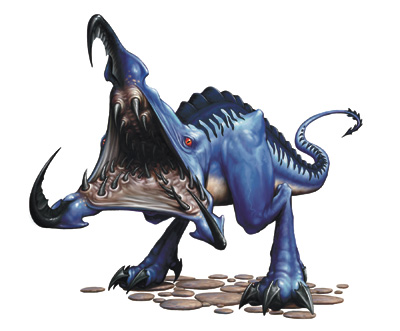
The Ethereal Marauder is another creature from the ethereal plane and actually native to that place. It also does not look nearly as insane as the ethereal filcher. It is also not much better as a monster, though, as it uses the same trick of popping out from nowhere, delivering a bite against their prey, and disappearing again until their target is dead. There isn’t really anything 3rd level characters could do about it other than readying an action, but as a GM, I would not allow players to say “I attack the thing when it pops up again in any of the six squares next to me”. At the very least you’d have to specific the space you are targeting and in that case the marauder just pops up behind your back.
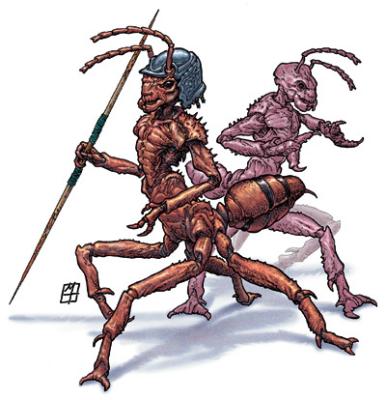
I believe Formians are a race that originates in Planescape, or at the very least had their greatest appearance in that setting. I think they have something to do with the border between the lawful outer planes of Mechanus and Arcadia, but nothing else is said about this in this book. They are still described as agressivelly expansionist, trying to create new colonies everywhere and taking control of every place they come to. There are several different types of formians, ranging from the small and quite weak workers to the very powerful myrmarchs and of course the magnificent queens. All formians within a 50 mile radius of the queen are always in telepathic contact with each other, making it almost impossible to surprise them or infiltrate their lairs. If one of them sees you, all of them know you are there instantly. Formians have various magical abilities depending on their rank. While workers are pretty weak and harmless, groups of them can work together to cast the spells cure serious wounds and make whole unlimited times per day, so any damage adventurers may cause to a colony will be very quickly repaired. Unless a formian is outright slain in battle, it will be back at full strength a few minutes later as long as workers can get to them. Taskmasters not only control formian workers and warriors, they also have the ability to telepathically control almost any kind of living creature and will almost always be accompanied by bodyguards of some other race. Myrmarchs have even more powers than that and the queen of a hive is always a sorcerer of at least 17th level. Even though workers and warriors are not very strong or dangerous by themselves, it is very unlikely that players will just run into a small group of them. Formians will almost always be encountered as a complete hive that at the very least consists of several dozens of warriors and hundreds of workers. And given their extremely effective organization they are also significantly more dangerous than just their individual numbers. If you’re using formians as opponents for your campaign and you are using them as described, it almost certainly should be as a major threat and the centerpiece of the whole adventure, most likely for pretty high level characters of 15th level or above.
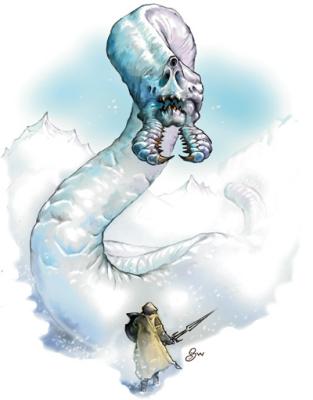
The Frost Worm is another Conan creature. But a pretty cool and also very bad one. It’s some huge kind of white worm native to arctic environments, but I believe it also has been used in high mountains in the Forgotten Realms. As expected, their bite deals extra cold damage and they have a freezing breath that deals a staggering amount of damage. They also can make a whistling sound that numbs the mind of any creatures within 30 meters, making them effectively stunned. When killed, a frost worm instantly turns into ice and explodes, dealing 20d6 points of damage to everything within 30 meters. The idea is fun, but why 20d6? This is a CR 12 monster and one I would most likely use against 10th or 9th level PCs as a kind of boss monster. And it uses the ability at the very end of the fight, when it most likely already did considerable damage to the characters. 20 to 120 damage against injured 10th level characters is not fun. That’s 70 damage on average, no 10th level wizard or rogue is going to have that many when at full health. Most likely several characters will be killed after they have already won the fight. Sure, you can defend against it because most of it is cold damage. But that requires knowing in advance that you are going to fight a frost worm and that it has this ability. Which is not how this game is supposed to work.
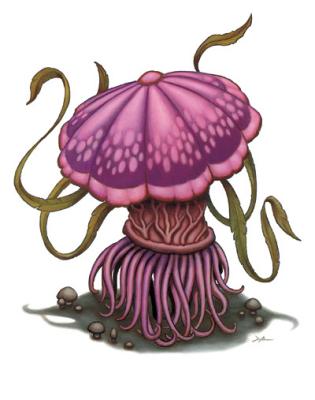
The Fungus entry is one I practically just skipped over from the very beginning. The shrieker and violet fungus are not really monsters but more like traps. A shrieker is a large subterranean purple fungus that really can’t do anything and has no Strength, Dexterity, or Intelligence score and Wisdom and Charisma scores of 2 and 1. They don’t have any attacks either and all they do is to make a loud noise when anything comes within a few meters of them, which of course will allert ant creatures in the surrounding area. A violet fungus poses are more direct threat, having long tentacles coated in a strength sapping poison. They can even slowly move around, though I don’t see how that will do them any good in a fight. I think both these types of fungus work best, or just work at all, in dungeons that are set up as dynamic environments. The only purpose of shriekers is to allert other creatures and make them come and investigate and a violet fungus is much more likely to severely cripple characters instead if killing them. If you go from room to room to kill the creatures that are waiting there for you, and there is really only one path to take through the dungeon, they are indeed entirely pointless. Which is probably why I never used them or saw them in any published adventures. They are most interesting when players set them off by accident, destroying all their careful plans to sneak into a place unnoticed, or when you know what they are and have to take them out in a stealthy way. Which both is pointless when you will kill every living thing in a straight up fight anyway.
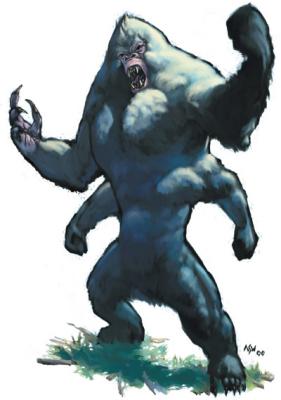
The Girallon is new in D&D but actually almost century old. It’s the great white ape from the novel A Princess of Mars. In most pictures I’ve seen of the great white apes they are shown to be pretty huge, while the girallon isn’t particularly big. It’s a gorilla with white hair and four arms, and that is really everything D&D did with it. Pretty disappointing and I don’t think it was used much. (Evil Ape +1)

The Gray Render is really a quite interesting creature. It’s a big beast of very simple intelligence with no real special powers, but with the natural instinct to become close friends with other smaller creatures. It most commonly has neutral alignment but will defend its small friends at absolutely any cost. I think it can be a really interesting addition to a group of kobolds, halflings, or druids, and with a CR of 8 it really is quite the nasty beast. I only saw a gray render outside the monster manual once, which was in an adventure for 15th level characters. Even advanced to more hit dice it really didn’t make any difference to the encounter it was part of. For some weird reason the book also tells us that gray renders don’t mate but simply produce an infant clone of themselves once in a while. This is an interesting idea once, but I think there is well over a dozen creatures in this book that reproduce this way, which really doesn’t make sense for complex creatures. While there are some species of small lizards that have such a way of reproduction, it’s an evolutionary dead end and can only work in small isolated areas for as long as the environment does not change. It just doesn’t make any sense in a large number of highly complex species, especially when most of them are supposedly ancient and highly advanced.
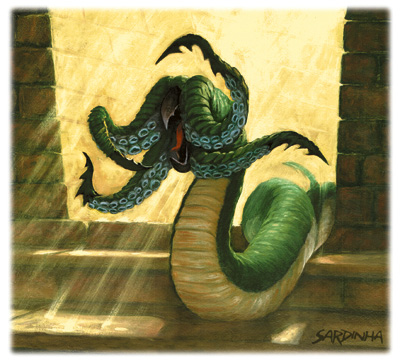
The Grick is a creature I always considered boring, and taking another closer look at it now and examining it for potential uses as an interesting encounter, I have to confirm: Yes, it really is boring. It is CR 3, has only 2 hit dice, an Intelligence score of 3, and is neutral. Damage from nonmagical weapons is reduced by 10, but with only 9 hit points that still doesn’t make them really a threat in the 3rd edition encounter system.They got these tentacles in their face, but even those just deal small ammounts of hit dice damage. (Because in the logic of D&D, four tentacles means four attacks per round and we can’t have them dealing too much damage.) The illustration doesn’t help them either, as even though they are aberrations the creature in the picture looks just like a big snakes with four smaller snakes instead of a head.
The Hell Hound is a dog from hell. It can breath fire and its bite deals fire damage, and it also is somewhat intelligent, though not very bright. (Demon Dog +1)
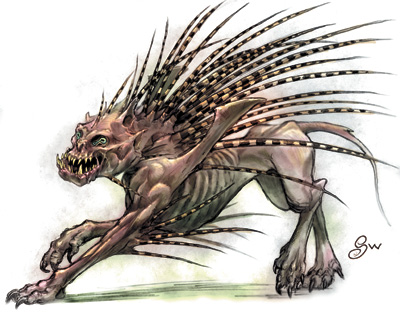
I have always liked the Howler, which again is entirely just because of the illustration. While the picture makes it look like some kind of demonic rat, a howler is actually larger than a horse and weighs about a ton, which I found really exciting when I actually noticed that some years later. They are pretty weak individually though, similar to hellhounds. Howlers are another Planescape monster, where they are native to Pandemonium, and endless system of caverns blasted by permanent winds. It is also notorious for making people quite mad and howlers a fitting right into that place. Anyone who hears the howlers howling in the distance must make a relatively easy saving throw or lose one point of Wisdom per hour. While not that interesting in a fight, I really do like their background and how they fit into the larger environment. But even though this particularly illustration doesn’t show it, they really are just another kind of demon dog. (Demon Dog +1)
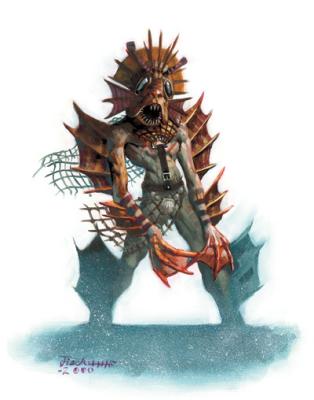
The Locatha is the most puzzling creature in the Monster Manual. Because it doesn’t have any even slightly interesting trai at all. It is an aquatic humanoid with 2 hit dice, completely average stats, and absolutely nothing else. And the picture looks stupid. I think I saw them mentioned once, with the Forgotten Realms Campaign Setting mentioning that they are distant descendants of one of the five first races that inhabited the planet a hundred thousand years ago. They never made any appearance, though. This is the lamest creature ever, making even wolves and dire rats exciting by comparison.
Monster Manual Cliche Creature Counter:
- Evil Apes: 1
- Variant Ghouls: 0
- Demon Dogs: 2
- Skeletons with Robes: 0
